Drishsho Madhyam Shilpi Shomaj makes bold statement with daylong programme
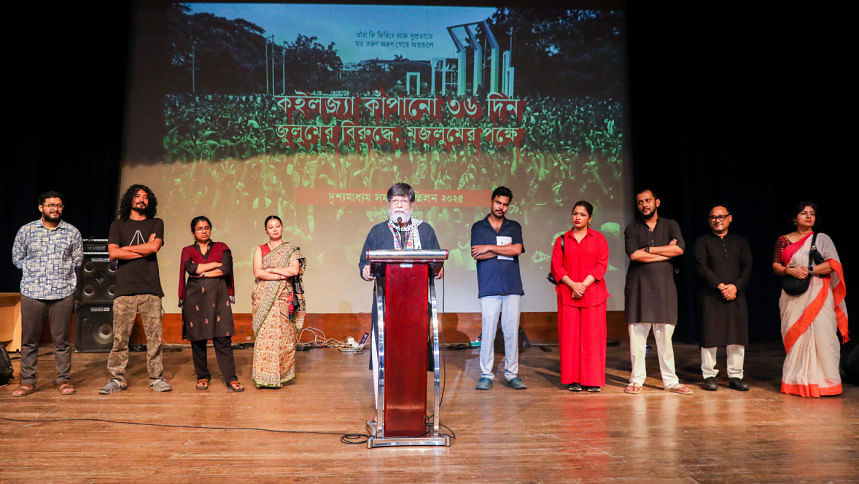
Throughout last July, Drissho Madhyam Shilpi Shomaj stood as a powerful voice of resistance – uniting artists, cultural activists, and public figures against the state-led oppression faced by protesting students. A year later, they came together to invoke the spirit of that movement with a daylong event held at the Bangladesh National Museum, bringing together survivors, families of martyrs, and cultural members together under one room.
The event, titled "Koilza Kapano 36 Din", the programme featured 13 film screenings, alongside powerful exhibitions of photography, posters, and live theatre. Musical and poetic performances filled the halls. The event was attended by families of the martyrs, along with a diverse gathering of thinkers, educators, filmmakers, photographers, theatre practitioners, writers, musicians, actors, and cultural activists.

The inaugural programme kicked off with speeches by Shamsi Ara Zaman, mother of martyred journalist Tahir Zaman Priyo, and Sabrina Afroz Sabonti, sister of Shaheed Mahamudur Rahman Soikot — both of whom delivered moving and emotional addresses.
Central to the event were two panel discussions that not only analysed the past but also imagined futures of resistance through art, activism, and solidarity.
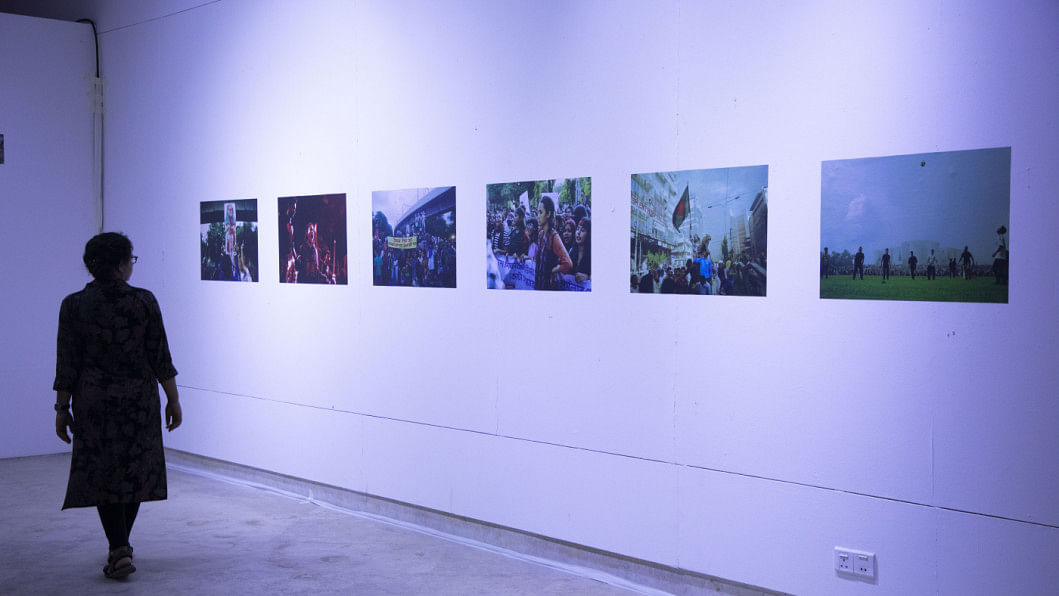
The first panel discussion, "Tara Ki Phiribe Aj Shuprobhate: Joto Torun Orun Gechhe Osthachole", brought together key cultural voices who had been vocal and present during the movement. Among them were photographer and human rights activist Shahidul Alam, actor Azmeri Haque Badhan, musician Hasan Aether, photographer and political activist Taslima Akhter, artist and filmmaker Ritu Sattar, producer Mushfiqur Rahman Manju, filmmaker Krishnendu Chattopadhyay, and costume designer Edila Farid Turin.
One of the most striking moments came from Shahidul Alam, who was startled when he was being told to sit in the VIP row, challenging the symbolic inequality embedded in such gestures. "I don't understand why you have a VIP seating arrangement," he said when he was invited to the stage. "I thought we were all equals here. The Bangladesh we dream of has no room for such discrimination."
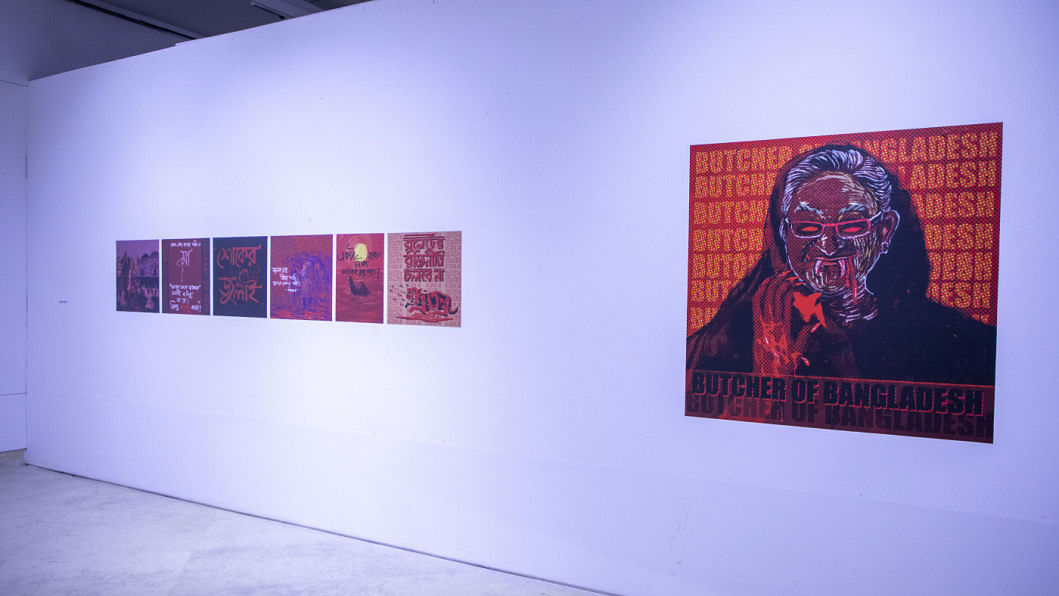
Alam's speech wove together past and present. Recalling the iconic image of Noor Hossain during the anti-Ershad protests. He talked about how Noor Hossain's body painted with the slogan "Sairachar Nipat Jak"— emphasised the transformative power of imagery in collective resistance. "He was not just a protester, he became a national symbol," Alam said. "That is the power of an image."
He went on to recount how, in 2010, his exhibition on extrajudicial killings, titled "Crossfire," faced intense government pushback under the Awami League regime. Initially advised by senior politicians Hasanul Haq Inu and Rashed Khan Menon to cancel the exhibition, Alam and his team persisted. "The police told us there was no law that allowed such an exhibition," he recalled. "They had power and guns, but they lacked creativity. So, we live-streamed the whole thing."
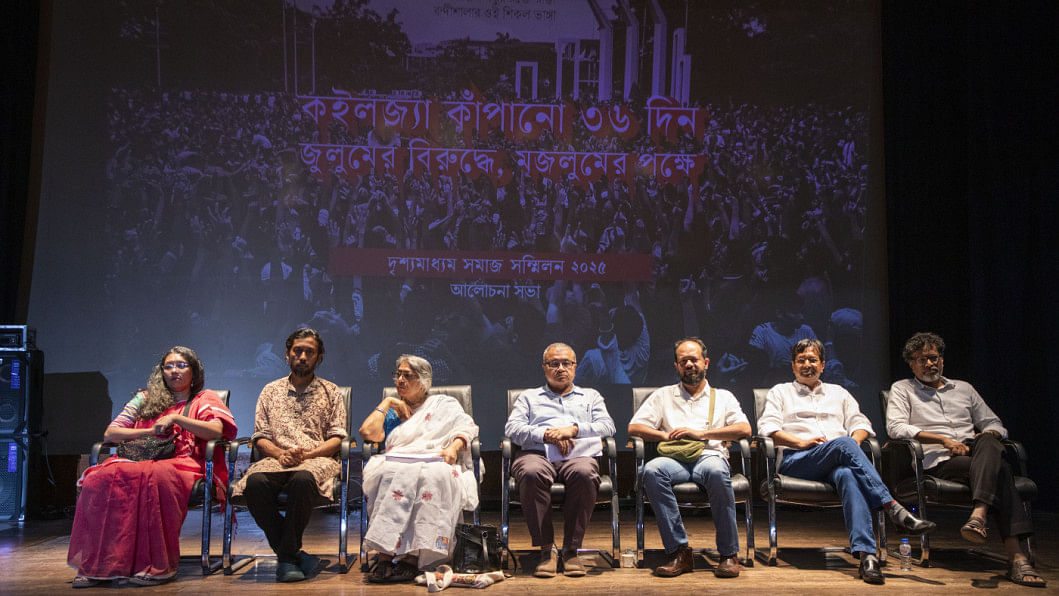
Despite attempts to shut it down, the exhibition was eventually allowed for one day. Alam described how they lined the entry path of then-Foreign Minister Dipu Moni with images the government had tried to suppress. "She had to smile in front of the cameras, even though inside she was likely furious. But she couldn't stop us. That's what creativity does, it finds a way."
Alam also criticised artistes who stayed silent during the July Movement. "Some will now claim they were with us. But we remember who spoke and who didn't," he said. His final message to the audience was clear: "Never accept VIP seats. If you're offered one, reject it. Equality begins with the smallest choices."
Actress Azmeri Haque Badhan also spoke with raw honesty. "I want to honour all the souls we lost and those who were injured," she said. "Back then, many of us had no idea what we were walking into. It was terrifying."

She credited fellow artistes such as Akram Khan, Dhrubo Hasan, Piplu R Khan, Zaheen, and Rajiv for encouraging her to join the protests. "If they hadn't been there, I don't think I would've had the courage to take to the streets," she said.
Despite her ongoing grief over the current political climate, she expressed hope. "I joined the July movement because I believed in the youth of this country. I still do. I believe they can help us become the nation we've always dreamed of."
Filmmaker Krishnendu Chattopadhyay reflected on the suffocating atmosphere under the previous regime. "We tolerated so much, but when we saw innocent students and workers being killed, we could no longer remain silent."

He recounted meeting the sisters of Shaheed Rabbi, who had searched for their brother from hospital to hospital. "Mitu and Mim never said they were looking for their brother. When they finally found his body, they joined a protest march—holding signs and demanding justice," he said. "Those two sisters had no one left. Yet they still stood up for others. They saw every student out there as their sibling."
"If a government doesn't understand that culture plays a vital role in a nation's growth," he concluded, "then that nation cannot move forward. But together, maybe we still can."
The final panel discussion, "Koto Biplobi Bondhur Rakte Ranga: Bondishalar Oi Shikol Bhanga", included voices of deep insight and experience: Samina Luthfa (theatre activist and educator), Shireen Parveen Huq (women's rights advocate), Munem Wasif (artist and educator), Amirul Rajib (art historian and curator), Firoz Ahmed (writer and politician), Sajjad Sharif (poet and editor), and Salimullah Khan (writer and scholar). The conversation focused on cultural resistance, public memory, and what it means to stand firm in the face of erasure.
The day ended on a high note with an evocative cultural performance segment. Artistes from across the country—Kafil Ahmed, Samageet, Warda Ashraf, Muiz Mahfuz, Hasan Aether (Highway), Deepak Suman, Sina Hasan (Bangla Five), Akil Ashraf (Pseudos on a Wrong Route), Upoma, Nizam Rabby, Sharif, and Teerondaz Repertory.
In an era where silence can be complicit, Drissho Madhyam Shilpi Shomaj has shown that the cultural front remains one of the most powerful spaces of dissent. Through music, poetry, images, and testimony, the gathering reaffirmed a shared belief: that even in the face of loss, censorship, and fear, a nation's conscience can be awakened through creativity.

 For all latest news, follow The Daily Star's Google News channel.
For all latest news, follow The Daily Star's Google News channel. 





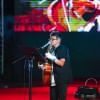
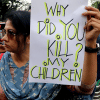


Comments